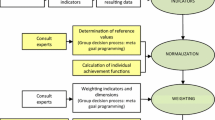Abstract
Sustainability is nowadays a key factor to analyse the development of the societies. Therefore, measuring sustainability is a main concern of the scientific community. The basic necessity to simultaneously consider the economical, social and environmental aspects make sustainability, by nature, a multicriteria concept, and therefore, multicriteria techniques are to be used to measure it. In this paper, we propose a method to develop synthetic sustainability indicators, based on the double (reservation–aspiration) reference point approach. This scheme is applied to each territorial unit considered, in order to determine, on the base of a given set of indicators, a couple of synthetic indicators that measure the weak and the strong sustainability of the unit.




Similar content being viewed by others
References
Charnes A and Cooper W (1961). Management Models and Industrial Applications of Linear Programming . John Wiley & Sons: New York.
Daly HE and Cobb J (1989). For the Common Good: Redirecting the Economy Towards Community, the Environment and Sustainable Future . Beacon Press: Boston.
Ferrarini A, Bodini A and Becchi M (2001). Environmental quality and sustainability in the province of Reggio Emilia (Italy): Using multi-criteria analysis to assess and compare municipal performance . J Environ Mngt 63: 117–131.
Geneletti D (2008). Impact assessment of proposed ski areas: A GIS approach integrating biological, physical and landscape indicators . Environ Impact Asses 28: 116–130.
López-Ridaura S, Masera O and Astier M (2002). Evaluating the sustainability of complex socio-environemental systems: The MESMIS framework . Ecol Indic 2: 135–148.
Luque M, Miettinen K, Eskelinen P and Ruiz F (2009). Incorporating preference information in interactive reference point methods for multiobjective optimization . Omega 37(2): 450–462.
Miettinen KM (1999). Nonlinear Multiobjective Optimization . Kluwer: Boston.
Munda G (2005). Multiple criteria decision analysis and sustainable development . In: Figueira J, Greco S and Ehrgot MM (eds). Multiple Criteria Decision Analysis. State of the Art Surveys. Springer: New York, pp. 953–986.
Nardo M, Saisana M, Saltelli A, Tarantola S, Hoffman A and Giovannini E (2005) Handbook on constructing composite indicators: Methodology and user guide. Statistics Working Paper 2005/3, OECD.
Nijkamp P and Vreeker R (2000). Sustainability assessment of development scenarios: Methodology and application to Thailand . Ecol Econ 33: 7–27.
Ruiz F, Luque M and Cabello JM (2009). A classification of the weighting schemes in reference point procedures for multiobjective programming . J Opl Res Soc 60: 544–553.
Torres-Sibille AC, Cloquell-Ballester VA, Cloquell-Ballester VA and Darton R (2009). Development and validation of a multicriteria indicator for the assessment of objective aesthetic impact of wind farms . Renew Sust Energ Rev 13: 40–66.
UNCSD (1996). Indicators of Sustainable Develoment: Framework and Methodologies. United Nations Commision on Sustainable Development: New York.
Wackernagel M and Rees WE (1995). Our Ecological Footprint: Reducing Human Impact on the Earth . New Society Publishers: Gabriola Island, BC.
Wierzbicki AP (1980). The use of reference objectives in multiobjective optimization . In: Fandel G and Gal T (eds). Lecture Notes in Economics and Mathematical Systems Vol. 177. Springer-Verlag: Berlin, pp. 468–486.
Wierzbicki AP, Makowski M and Wessels J (eds) (2000). Model-Based Decision Support Methodology with Environmental Applications. Kluwer Academic Publishers: Dordrecht.
Acknowledgements
This research was partly supported by the Andalusian Regional Ministry of Innovation, Science and Enterprises (PAI group SEJ-445) and by the Spanish Ministry of Education and Science (Research Project MTM2006-01921).
Author information
Authors and Affiliations
Rights and permissions
About this article
Cite this article
Ruiz, F., Cabello, J. & Luque, M. An application of reference point techniques to the calculation of synthetic sustainability indicators. J Oper Res Soc 62, 189–197 (2011). https://doi.org/10.1057/jors.2009.187
Received:
Accepted:
Published:
Issue Date:
DOI: https://doi.org/10.1057/jors.2009.187




